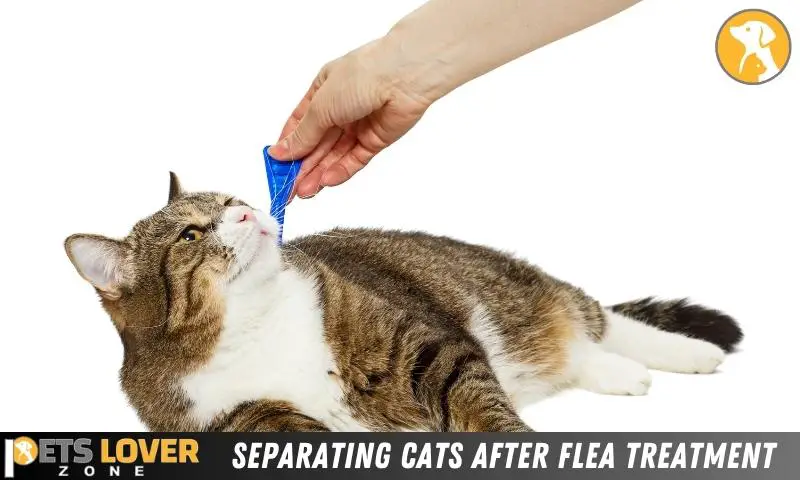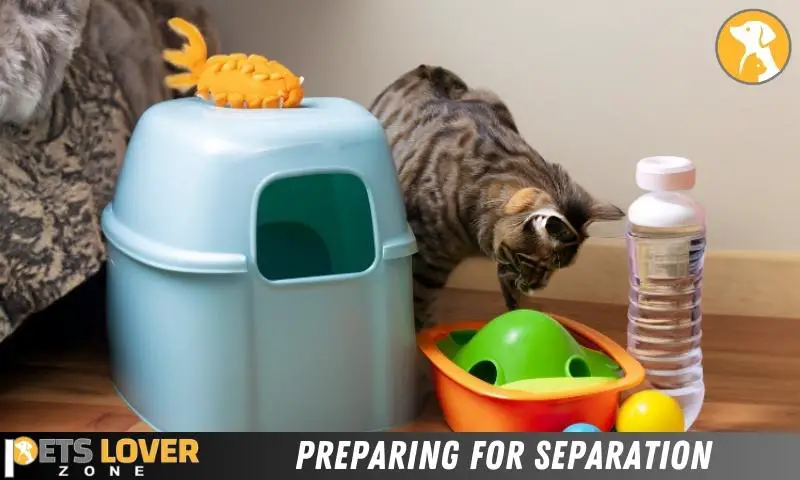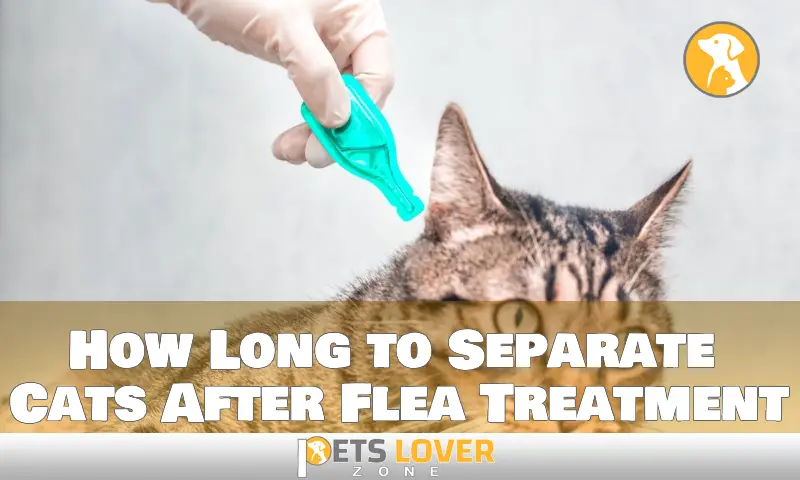Separate cats for at least 24 hours after flea treatment. Ensuring their toys, bedding, and litter boxes are not shared is crucial to eliminating fleas from your home.
Fleas can be a nuisance for both humans and pets. While flea treatments can help address the problem, it’s essential to take precautions and prevent cats from spreading fleas to each other during the treatment and afterward. According to veterinarians, separating cats for at least 24 hours after flea treatment is crucial to ensure the treatment is effective and prevents re-infestation.
In addition, it’s crucial to wash the cat’s bedding, vacuum the house, and use flea prevention products regularly to prevent the spread of fleas. Additionally, pet owners should keep a lookout for any signs of a flea infestation and take immediate action to prevent the situation from worsening.
The Importance Of Separating Cats After Flea Treatment

As a responsible pet owner, your priority is to keep your furry friends happy and healthy, especially when it comes to flea infestations. Once you’ve treated your cats for fleas, it’s essential to keep them separated from other cats to ensure their safety and prevent further health issues.
Why It’s Important To Keep Treated Cats Separated From Other Cats
Here are the significant reasons why you should separate treated cats from other cats:
- Flea treatments contain potent chemicals that can harm other cats if they ingest them. For example, if a cat licks the flea treatment residue on another cat’s skin, it can cause drooling, vomiting, diarrhea, and even seizures.
- Separating treated cats from other cats minimizes the risk of re-infestation. Fleas can spread rapidly, and if one cat has fleas, the entire household is likely to have them, too. To avoid this, separate the treated cat to ensure that fleas don’t jump onto them from other pets.
- A clean environment is critical to maintaining flea-free cats, and separating treated cats from other cats can help with this. Fleas from the treated cat may survive in the environment and re-infest the uninfected cat even if the uninfected cat is protected by flea prevention medication.
The Risks Of Not Separating Cats After Flea Treatment
Not separating treated cats from other cats can result in the following risks:
- Other cats can ingest the medication accidentally, causing them to suffer from various health issues.
- Treated cats can re-infest other cats with fleas, making the flea eradication process more challenging.
- Fleas can spread disease to other cats, especially if they are not treated immediately. Some of these diseases can be severe, causing long-term health issues.
Fleas can be a real nuisance for cats and their owners, but the right approach can help prevent them from becoming a significant problem. By separating treated cats from other cats, you can ensure that all cats in your household are protected from flea-related health issues.
Preparing For Separation

Cats are commonly infested with fleas. These minuscule insects can even prey on indoor cats. Treating your cat with flea medication is the most common way to get rid of fleas. However, after treatment, it’s essential to keep your cat away from other pets and children for a limited period of time.
In this blog post, we will explain how long it takes to separate cats after flea treatment and what supplies you will need.
Preparing A Room Or Space For Your Cat
The first step is to select a designated room or space where your cat will remain after flea treatment. Make sure that the area you choose is quiet, comfortable, and free from other pets and children.
Here are some tips to prepare the space for your cat:
- Clean the selected room or space before your cat arrives. Remove any clutter, toys, or food from the room.
- Make sure the room has enough space for your cat to move around comfortably.
- Add a litter box, food, water, and some toys to keep your cat entertained.
- Cover the floor with a comfortable blanket or towel.
Necessary Supplies For Separating Cats After Flea Treatment
After preparing the room or space for your cat, make sure you have the necessary supplies before separating your cat from other pets and children. Here are some of the essential items you will need:
- Flea medication for your cat
- A collar and ID tag
- A litter box
- Non-scented litter
- Food and water bowls
- Food (wet or dry)
- A few toys to keep your cat entertained
- A comfortable bed or blanket
It’s essential to separate your cat from other pets and children after flea treatment to ensure that they don’t get re-infested. By following the above steps and staying with them, you can ensure that your cat recovers from flea treatment appropriately.
Separating Cats After Flea Treatment
How Long To Keep Cats Separated After Flea Treatment
It’s vital to keep your cats separated for a period of time after administering a flea treatment. You don’t want to risk them ingesting any of the chemicals. But how long should you separate them? Here’s what to consider:
- Check the instructions provided by the flea treatment manufacturer. The length of time stated will vary depending on the brand used.
- On average, cats should be kept apart for at least 24 hours to allow the treatment to dry and settle.
- Take into account the individual temperaments of your cats. Some may be more prone to licking themselves and ingesting the treatment, so need to be kept apart for longer.
- Monitor your cats for any signs of illness or adverse reactions to the flea treatment. Seek veterinary advice if they do not appear to be responding well.
Steps To Separate Cats After Flea Treatment
So, you’ve established how long to separate your cats. Now, what steps can you take to ensure their time apart is as stress-free as possible?
- First and foremost, ensure both cats have access to food, water, and a litter box in their separate areas.
- Provide each cat with a safe and comfortable spot to relax and sleep. This could be a separate room or area of the house.
- Give each cat plenty of attention and affection throughout the separation period to prevent them from feeling too lonely.
- Use pheromone diffusers or sprays, such as Felineway, to help keep your cats calm and relaxed.
- Gradually reintroduce your cats to each other once the separation period is over. Start with supervised playtimes, then gradually increase the amount of time they spend together.
Don’t rush the reintroduction process – it’s important to make sure both cats are comfortable and happy before they’re fully reunited.
Monitoring Cat Behavior After Separation
Cats are delicate creatures, and it’s important to monitor their behavior after flea treatment. Separation is necessary to avoid any harm to one another as well as to minimize their exposure to the chemicals present in flea treatment. However, it’s essential to keep an eye on their behavior to know if they are having an adverse reaction.
Here’s how you can monitor your felines.
Signs Of Reaction To Flea Treatment
- Vomiting and diarrhea: These are common indicators of a negative response to flea treatment. You should monitor how often and how much your cat is vomiting or having diarrhea, and be sure to call your veterinarian if these symptoms persist.
- Lethargic behavior: After flea treatment, it’s common for cats to feel drowsy or tired. However, if this behavior persists, you should consult with your veterinarian, as it could be an indication of an adverse reaction to the treatment.
- Excessive drooling and scratching: If your cat has a lot of drool around its mouth or excessive scratching after flea treatment, contact the vet immediately.
Keeping Cats Comfortable And Calm During Separation
- Location: Keep your cats in separate locations during this period of separation. Cats might get competitive and aggressive toward one another, and keeping them apart can avoid this.
- Check on them regularly: Make sure to check on your cats regularly during this time. You can spend some time with them or give them some treats so they don’t feel lonely.
- Toys and treats: Cats love toys, and they are a great way to keep them engaged. Provide them with plenty of toys and treats so they can have something to do while they are separated.
Monitoring your cat’s behavior after flea treatment is essential, as it can prevent any adverse reactions and keep your cat safe. Keeping them comfortable and calm during separation can help improve their mood and reduce any anxiety they might have.
By following these steps, you can ensure your cats stay safe and healthy during the delicate period following flea treatment.
FAQs
How Long Should I Keep My Cats Separated After Flea Treatment?
It is recommended to keep your cats separated for at least 2-3 hours after flea treatment. This allows the treatment to dry and be absorbed into the fur properly.
Can Fleas Still Be Present Even After Treatment?
Yes, it is possible for fleas to still be present even after treatment. Some treatment options may only kill adult fleas and not the eggs or larvae.
How Frequently Should I Treat My Cats For Fleas?
It is recommended to treat your cats for fleas every 4-6 weeks, especially during flea season. This helps prevent flea infestations and keeps your cats healthy.
Conclusion
After flea treatment, separating cats for a specific period is an essential step to ensure they are protected from further infestation. It’s recommended to separate cats for at least 24-48 hours after the flea treatment application to allow enough time for the product to be absorbed and dry completely.
Pet owners need to provide a comfortable and safe environment for their pets during this time, making sure they have access to food, water, and litter boxes. It’s also important to keep an eye out for any adverse reactions to the flea treatment.
Understanding how long to separate cats after flea treatment helps keep them healthy and happy. By following the guidelines provided by your veterinarian or the product manufacturer, you can ensure that your pets are protected from flea infestations and enjoy a flea-free home.
With proper care and monitoring, your cats can stay healthy and happy.





